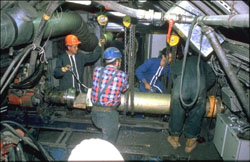In search of a geological repository for radioactive waste
Increasing attention has been focussed on nuclear power as a carbon-free source of energy. However, nuclear energy has its own environmental challenges, one of which is safe disposal of the spent fuel. Before a geological repository can be constructed, the behaviour of the surrounding rock must be fully understood. The Fifth Framework Programme funded research in this field, including the HE project, which examined the effect of heat on the properties of Opalinus clay and compact bentonite. Emissions of carbon dioxide (CO2), hydrocarbons, hydrogen, oxygen and other species were measured under normal conditions as well as at the HE heating tube installation. Other parameters, such as temperature, humidity and pore pressure were also monitored. Analysis of the dataset was led by GRS, a member of the HE research consortium. At temperatures normally associated with mines, in the order of 14°C, oxidation of hydrocarbons consumed oxygen and contributed to increased CO2 emissions. Decay of uranium contained within the clay also led to the discharge of small amounts of helium. GRS concluded that variability observed between measurement sites could primarily be attributed to inhomogeneities in the Opalinus clay. In the laboratory setting, at temperatures approaching 100°C, gaseous emissions were dominated by CO2 and, to a lesser extent, hydrocarbons. In the field, where temperatures reached a peak of approximately 50°C, no major changes in rock properties were perceived over a period of 18 months. However, GRS and its HE partners stress that this result cannot be extended to higher temperatures without further field experiments.



